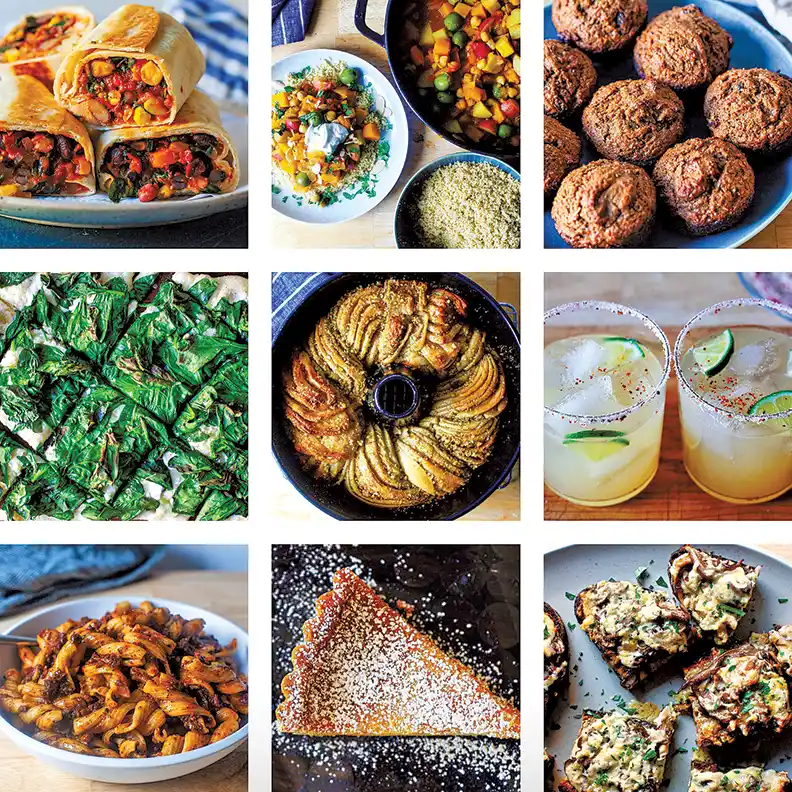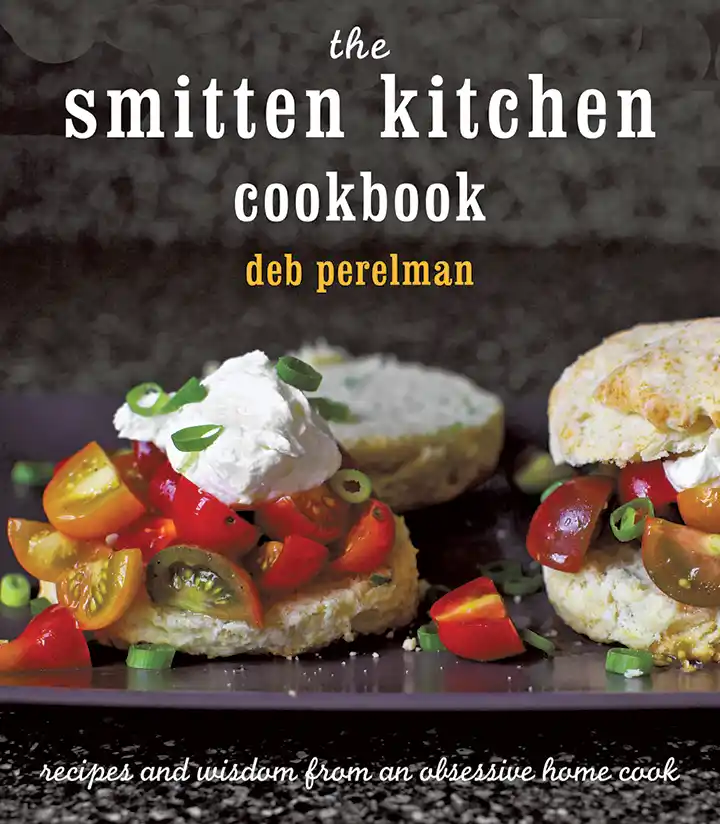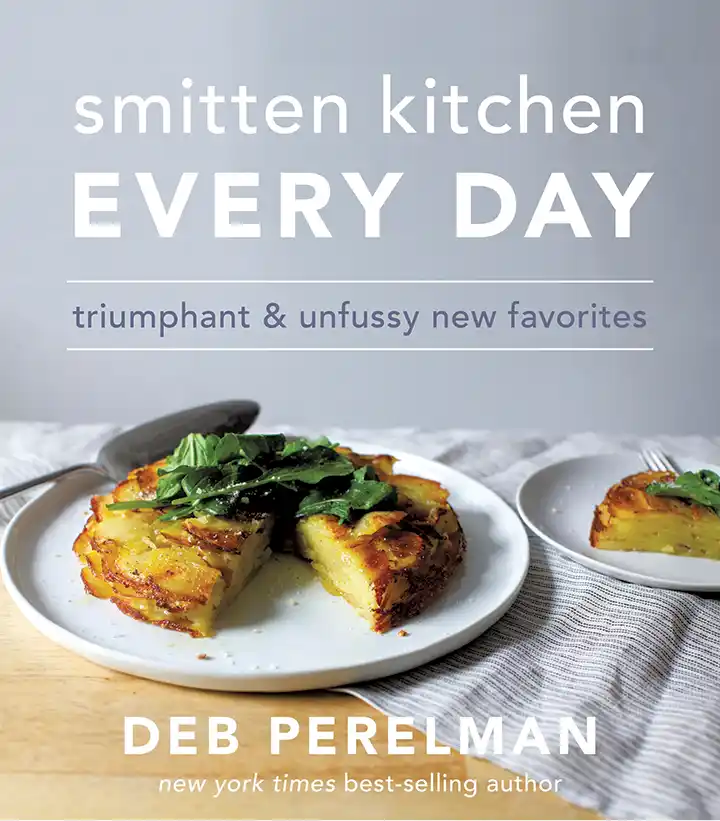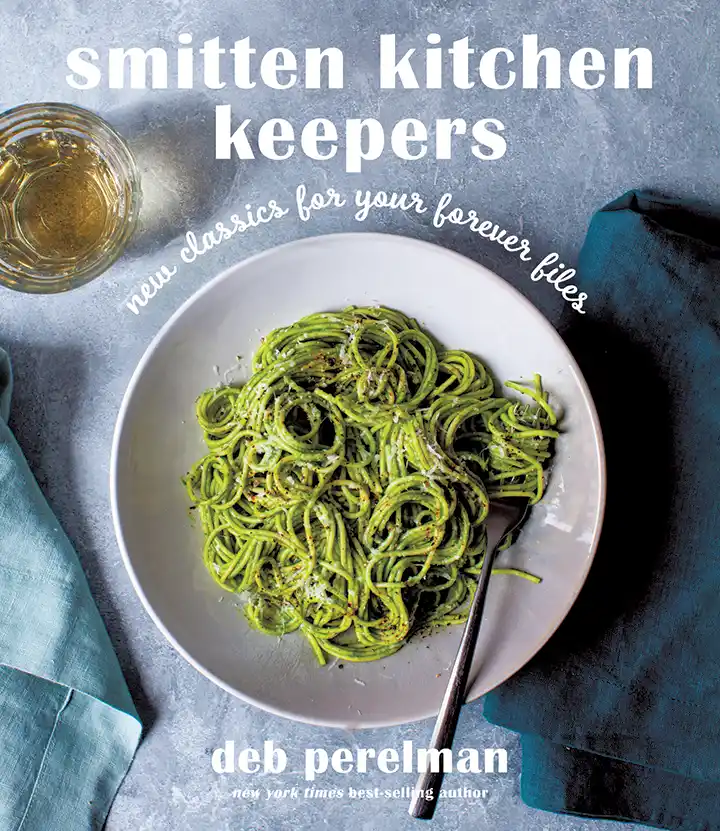
Founder, Smitten Kitchen
Deb Perelman has become a digital sensation over the past decade. Her enormously popular blog, Smitten Kitchen, has turned into a burgeoning media empire with three bestselling cookbooks and her branded content on the Food Network.
Her books have enabled her to talk with adoring fans during book signing tours from Coast to Coast. She boasts some 1.7 million followers on Instagram.
After writing online for fun for several years, Deb had the idea in 2006 to start Smitten Kitchen. At the time she was an IT reporter (and before that, an art therapist, record store supervisor, barista, swimming instructor, you name it), a job she kept until 2008.
She and her husband lived in an apartment across town in Chelsea with a similarly small kitchen and a positive attitude about it to match.
There she began to cook and photograph original recipes and became known as an obsessive home cook.
She became a master of battling a challenge that we see every day in commercial foodservice: minimal prep and cooking space.
The genius of Deb’s recipes is that they combine great ideas, while only using ingredients and equipment that the average cook has at their fingertips.
With so many of us looking to find their “new normal,” Total Food Service sought out Deb Perelman to get her thoughts on how “out of the box “ creativity can create success in 2023.
Can you share a little about your background prior to creating the Smitten Kitchen?
Sure. I grew up in Somerset, New Jersey. After college, I had a lot of different jobs. I was an art therapist for a bit, I was a law manager at a record store and I worked for a B2B tech publication.
I wrote about business tech and I was very bad at it. I was very bad at most of these jobs, to be honest.
Did you ever work in a restaurant environment?
I worked in a bakery when I was in high school, and at a coffee shop and an ice cream shop when I was in college. I always loved being around food, but I didn’t start working in it for many more years.
Where did the idea of Smitten Kitchen come from?
I had started cooking a lot more at home, and I really just wanted a place to collect my go to recipes. My chicken always works, don’t make this, make cake, make this one, and just the stuff that I was figuring out.
When I find something that works, I want everybody else to make it the way I do.
When you launched Smitten Kitchen, did it start as a part time hobby? Talk about what it is and how it has evolved.
When I started, it was just a food blog I was working on in the evening. Sometimes I would take pictures of my food, not always in the beginning, and I would say, here’s something I made for dinner last night, it was really great.
And it was really just “Here’s the recipe, this is how I’ve tweaked it,” that kind of thing. And it was always about going to keeper recipes, things that I felt were worth your time, and things I wanted to give you a head up about.
It pretty much started as that, and then as it gained an audience and it gained a lot of following and a lot of energy, it became my full-time job.
What is it that attracted people to the brand? Was it you or the food? Talk a little bit about that.
I’m very nitpicky about recipes, not about making them fussy, but about making them work. And I think we’re all just looking for recipes that work.
We like it when people explain it to us in plain language. I have no cheffy authority whatsoever. I’m always just trying to say it to you the way it would sound if I was saying it to you right now.
And I think that makes it a little more approachable, nobody’s being bossed around or condescended to, it’s just about making it work in your kitchen.
So, it was just one home cooked to another. I always thought of showing my age here, but you know in the kitchen you have the long telephone cords back in the day, I always had this image of my mother, she’s making dinner and she’s talking on the phone to another friend.
And they’re like, oh, so this is how you do it. You do it this way. Okay, so I cut it this way. And I just didn’t see or hear a lot of that in cooking conversations.
It was always about chefs telling you what to do. But that’s not necessarily relevant to my life at 5pm when I’m trying to get some food on the table.
We’re fascinated by this idea of fearless cooking. What is it?
I think people are so intimidated by home cooking, I always hear, “Oh, I can’t work with yeast, or egg whites never whip for me, and I just don’t think I’m going to make caramel.”
And I’m like, it’s just melting sugar. You just put the sugar in the pot.
I try to just get people to do things they’re afraid of, because I don’t know about you, but I get most of my energy from doing things that scare me and pulling them off, so I want people to have those triumphant feelings in the kitchen.
Cooking can accomplish that.
I think it can! The first time you’ve made bread from scratch, you probably felt pretty triumphant, right? That was way more fun than just defrosting it.
You must have an interesting perspective looking at the restaurant foodservice industry. Do we have any idea what we’re doing? What do you see?
I think that you have a lot of idea what you’re doing. I think I have very little idea. But we go out to restaurants a lot. I live in Manhattan and we go out, I love going out, and I love seeing what restaurants are doing.
And I always wonder, how do they make this work? How does this work? How do you get all these short ribs executed?
How do you get all these seasonal vegetables in March in New York City? I’m not an expert, but I’m an observer of the end results.
As you observe and you watch, you remember the days when we had these open kitchens, and that was a big thing.
What are your observations of how the restaurant business has changed and evolved? And obviously, we just went through two and a half years of either being closed, or takeout and delivery, etc.
I think that restaurants really took a hit, it was really horrible, the way it was so damaging and how people would make time for almost anything besides going to a restaurant.
And I know it was really damaging, we lost a lot of really great ones that we shouldn’t have. I also think that you’ve got the shipping prices, and then you’ve got inflation, and food costs are just off the chain right now.
And it’s just even little things. I see it in the restaurants, I can’t get over what some things cost anymore, and it’s really making people baulk just as they come back.
I want to come back and support these restaurants, and I want everyone to be paid fairly, but I also cannot afford to order short ribs at a restaurant anymore.
It’s just not a thing. I can’t do it. I think the restaurants that are doing a really interesting job are finding ways to do really amazing work with lesser expensive cuts of meat.
And really, this is what you want a restaurant to do. You want them to transform an ordinary ingredient to the extraordinary. So, I think that it’s maybe less on the high ticket known things and more on creativity.
I had an incredible beef rib at a restaurant last night, which was, I don’t want to say it’s reasonably priced, because it’s Manhattan, but it was a lot better price than I’d seen.
I haven’t done a lot with beef ribs, and I want to play around with this. I thought that was a really interesting pivot.
You mentioned cooking like a restaurant chef. What does that mean? What’s your definition of that?
To me, it’s a completely different process than any of us have as home cooks. You’re going to mix it out, you’re going to have everything prepped beforehand, you’re going to fire it per order.
I don’t think when you look at a restaurant chef’s recipe, it works for home cooks, I think that we cook completely differently. We’re chopping as we go, and we’re not firing each dish individually.
A lot of times when you look at a restaurant recipe, it doesn’t work for you at home. But if somebody can take those ideas and parse it in a way that we could make it on a Tuesday night, there’s stuff there that you can use.
But it’s a completely different process at a restaurant.
We often wonder if home cooking and being a restaurant foodie can coexist.
They should coexist. That said, when I go out to a restaurant, I’m kind of looking for something, maybe I’m not pulling off at home.
If it feels like something, I could just make so easily it doesn’t feel that special. But I like seeing, show me something cool you can do.
As I said, the restaurant process is so different, where you’re prepping everything in advance, and you can go singe and sear and make a quick sauce to order.
I want that, I want that thing I can’t do at home. It’s just like everything in a pot and you bake it or you boil it. I’m like, I’ve got that covered.
The other thing we’re always curious about is equipment. A restaurant has a broiler that can do 700 degrees or a pizza oven, etc. Should home cooks feel limited by the equipment that they have access to? Should they adapt? What difference does driving a ‘big car’ or a ‘small car’ make when you’re cooking?
It can make a really big difference if you’ve got access to a pizza oven, I know people who have them at home, and their ovens are really hot, they’re very happy.
That said, my obsession is recipe writing, and I think a good written recipe will get you as close as you can with what you have.
I’m writing for people with crappy ovens like mine, and are trying to, so get as close as you can, and here’s a cool technique I found, that it doesn’t quite give you the crust of a 900 degree pizza oven, but it’s getting there.
What will an example be of something like that?
It’s not perfect, but I know a lot of people like pizza stones and stuff like that. There’s also these pizza seals that have become very popular in the last several years, you get it really hot.
I actually like a longer ferment almost softer dough because it gets less crackery, and you get more of those big and small holes you’d like from a pizza.
Again, I haven’t quite worked it out, but just getting your oven as hot as it can go, keeping it there for a while and having something in there that’s already hot, it’s not the same, but you can feel pretty good about it in a home cooked kitchen, and then you save some money.

We live in an industry that was reimagined by social media. We went through this entire period where everything was about how you could shoot a picture of it, and what it would look like on Instagram. It’s kind of what you do for a living. Where does social media fit in terms of how a Smitten Kitchen or a restaurant could be marketing, what it is that they’re doing?
It really matters and it’s not going anywhere. Even if I’m going to a restaurant, I want to flip through, not just their pictures of the food, but I also sometimes look at what people are tagging them.
You kind of flip to the backside of the screen and then you can see just how the dishes are looking. It gives you an idea of whether you want it, and I think it’s really nice to have those visual guides.
I’ll even go on Google listings and flip through pictures of the restaurant. It gives you an idea of whether the vibe is really fancy or really casual.
You can’t always get that from a restaurant description or the menu. I find it really helpful, and I don’t think it’s really going anywhere, I think it helps us make better decisions.
In the same way I write cookbooks, and when a cookbook recipe doesn’t have a photo, we’re all kind of like, and that used to be standard that not every cookbook recipe had photos, but nowadays when a cookbook recipe doesn’t have a photo of their dish, you feel a little lost.
You’re like, I can’t picture it, can you just show me what this looks like?
Do you have any advice for a restaurateur trying to use social media to properly market?
I don’t think it needs to be. I think get away from the super edited, super touched up. I think people just show bits and pieces from behind the scenes, like here’s something new we’re working on, or oh, we’re so close to this.
People love it and it really builds your restaurant community because if this is your neighborhood restaurant, and they’re just chatting oh my god, we got the first rhubarb from the Union Square Greenmarket today, we’re going to make these tarts with it tonight.
In fact, when overly marketed and edited, you can feel that a marketer or PR agency did it. You don’t really want that. So, I think a little messy, a little scrappy, and just do it on your phone, don’t worry about the lighting.
We’ve spent a lot of time in our world on the addition of plant-based food. What are your thoughts? What are your comments? Is it a fad? Is it something that’s here? I’m confused because all I seem to see is food that’s replacing the existing. I don’t understand it.
It’s interesting because I think there’s two parts here. There’s a vegetable centric diet, which I think more and more people are interested in, and they want to see innovative uses of vegetables, and have vegetables in the center of the plate, and maybe meat on the side.
They want to have a vegetarian main that’s not just like a pasta with chopped eggplant or something like that. And I think that’s not going anywhere.
And I eat like that too. We do eat meat, but I love that. And then you have the food product and fake meat. And I don’t know, I’m not an expert, but as a consumer, I look at it and there’s a lot of ingredients.
There’s a lot of ingredients, there’s a lot of processes. And I just don’t know, personally as somebody who just likes lentils, beans, tofu and vegetables, that it’s not really for me, but I think for a lot of people it’s allowed them to go over to a less meat centric diet.
It’s been like a stepping stone for them. I don’t know if it’s going to be really big in a couple years the way it is now, but I think for a lot of people, it’s sort of their entry point to eating less meat centric, which is probably better for the earth in the long run.
What about things like seaweed? Do you see other cooking techniques that are impacting how people cook at home? And now I’m seeing a decent amount of seaweed in commercial kitchens as well. What are your thoughts? What do you see?
I think it’s not going anywhere. I think people really like the texture, and in part for a restaurant, they can sort of do this. This is the kind of thing you’re probably not going to do at home, the 14-hour seaweed.
Who plans like that? In two days, I’m going to go eat this thing. For restaurants it’s great. And then they can kind of sear it off in a pan and you get this unbelievable texture.
And they’re taking the same piece of meat that you can buy but they’re doing something with it that you would never get at home. I think it’s great.
And I think I totally see why people want to experiment with it at home. I don’t think it’s going anywhere even if it might have its ebbs and flows.
The other thing that’s interesting is the definition of a foodie. Is a foodie now somebody who does what you do and cooks at home, and also goes to restaurants and eats out? In other words, what’s a foodie? How do you define it?
I don’t think there’s exactly one answer, but generally, it seems for people food has left the realm of sustenance and become a hobby.
Or maybe it’s chasing new foods. Maybe it could be trying new foods at home, but I feel like there’s definitely something where it’s a bit of a hobby to chase new flavors and new chefs.
I guess it’s an activity and not just about like, I have to live so I will eat many meals a day.
You must see a lot of new and innovative equipment for residential kitchens. What does that whole world look like? Are manufacturers doing a good job of listening to folks like you about what you need? Talk a little bit about that.
People were making more complicated pasta shapes at home, they have these machines now that you just dump in the flour and it’s done.
For me, I have the pasta wheel, so I’ll make spaghetti or linguini or lasagna sheets, but I’ve never done extruded pasta. Lots of people are doing extruded pasta at home, I think it’s really interesting.
I probably don’t need to mention the Insta pot or the air fryer, they’ve had a hold on the market for years now. I see a lot more people using the good ice cream makers at home, the ones with the compressor versus the freezer bowl, they have to freeze for two to three days to use once.
I’d love it if the prices came down on that even further, they’ve come down a lot. I actually bought one when they came down a couple years ago.
But I can see a lot more people buying that and making ice creams at home. I love doing that.
We want your thoughts. Can you learn to become a great cook?
Absolutely. I actually don’t think there’s bad cooks, I think there’s bad recipes. I think the right recipe should get you there. If you follow it, and you do exactly what it says and look out for the things, that’s my goal in recipe writing.
I don’t think that you should have to know how to sauté or mix fried rice or anything like that, I should be able to explain to you. And if it’s not working for a lot of people, I didn’t explain it well enough.
Good answer. We just chatted with Emeril Lagasse a few weeks ago, he just went to work for Carnival as their Chief Culinary Officer. It was shocking that he said that they’re getting out of the business of people eating 10 meals a day on a cruise. Are we getting out of the gluttony business? Is there finally light at the end of the tunnel in terms of how we are eating and what we’re eating?
It’s hard to say because I think you always have these dueling forces. Most of us are looking for a nice dish with vegetables that isn’t too over the top. It might be our ages or what our bodies are doing.
We want to feel good. And I think the health and wellness moment has made us want to eat food that feels good and feels sustainable. That said, I don’t think fast food has ever been more popular.
And it’s not even the opposite, but you also have people who have like crunch wrap supreme copycats, and Doritos crusted chicken fingers are delicious and not going anywhere.
So, I think that there’s always going to be both, we’re never just going to be salad people all the time.
In terms of the volume we eat, I think that there has been a good conversation happening for a lot of years that our dinner plates are just bigger in this country, and they get bigger every 10 years, and we put more food on them.
And our idea of what a portion is, is really out of whack with the rest of the world. I think this is important stuff to know about.
Do you feel any responsibility to kids in the next generation to help them learn how to eat properly?
I think being able to cook is a life skill. And previously, we would teach it to women, and it was part of the Home Economics class.
Then we started teaching it to nobody, which I don’t think was a winning battle either. We need to remove the gender of it. Everybody needs to learn.
My son wants to learn how to scramble eggs and make an omelet, make spaghetti sauce. I want to arm him with the ability to take care of himself with basic, inexpensive foods that will fuel him.
To learn how to make a salad dressing. It’s not complicated, but I think it’s life skills, it should be as important to teach your kids as how to tie their shoes and make their bed.
We managed to genderize everything.
Yeah, but we just took it away from everybody. I think we’re coming back. And I actually see a tremendous amount of younger people at my book tour events, where somebody will come with their 10 and their 13-year-old and they’ve cooked through my book!
That’s amazing.
Love it. Why should a restaurateur or somebody working for a food distributor take a look at becoming part of the Smitten Kitchen community? What’s there that’s fun and interesting?
Great conversations from people, and also, the recipes work. I’ve done a lot of work to remove steps from recipes and get the most flavor out of simple ingredients, and I very rarely call for anything complicated.
It’s a lot of one bowl cakes, and reliable zucchini bread, and a perfect weeknight lasagna with a lot of vegetables in it. And I just test and test and test until I’ve removed all of the scrap, all of the headaches, all of the extra steps.
And I feel like that could be useful because you still need these things.
To learn more about all of Deb Perelman’s work, visit Deb Perelman’s website, or follow her on Instagram, Twitter, or Facebook.
All book photography courtesy of Smitten Kitchen. Deb Perelman photo by Christine Han Photography.


























